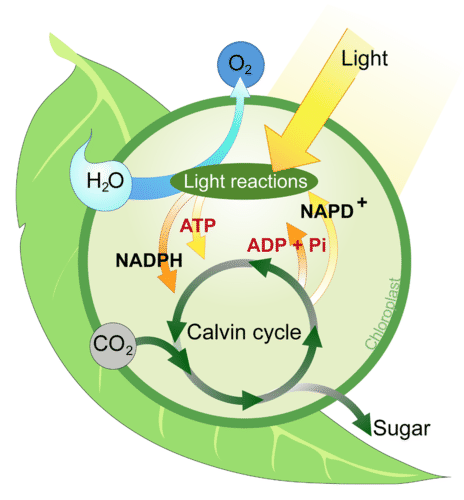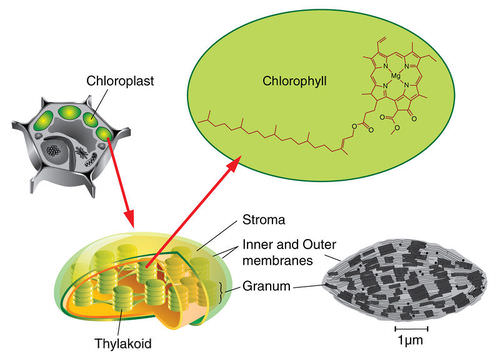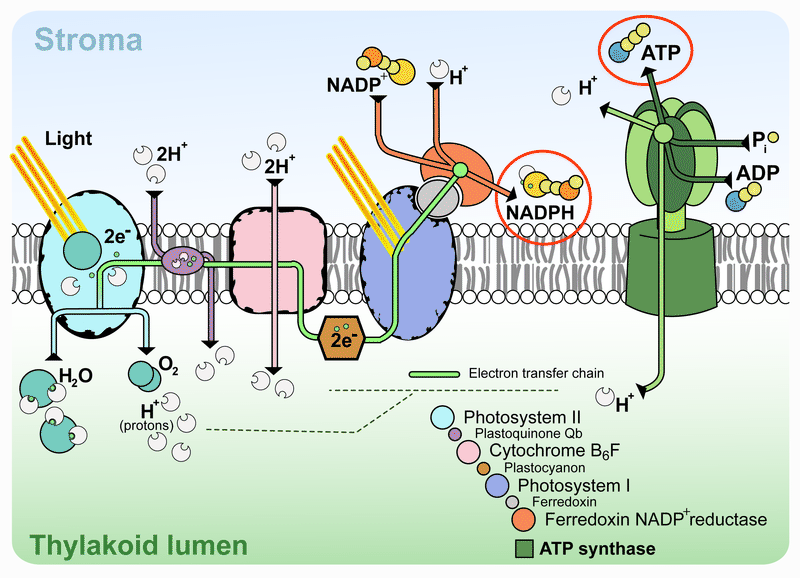2.10: Chloroplast
- Page ID
- 8368
\( \newcommand{\vecs}[1]{\overset { \scriptstyle \rightharpoonup} {\mathbf{#1}} } \)
\( \newcommand{\vecd}[1]{\overset{-\!-\!\rightharpoonup}{\vphantom{a}\smash {#1}}} \)
\( \newcommand{\dsum}{\displaystyle\sum\limits} \)
\( \newcommand{\dint}{\displaystyle\int\limits} \)
\( \newcommand{\dlim}{\displaystyle\lim\limits} \)
\( \newcommand{\id}{\mathrm{id}}\) \( \newcommand{\Span}{\mathrm{span}}\)
( \newcommand{\kernel}{\mathrm{null}\,}\) \( \newcommand{\range}{\mathrm{range}\,}\)
\( \newcommand{\RealPart}{\mathrm{Re}}\) \( \newcommand{\ImaginaryPart}{\mathrm{Im}}\)
\( \newcommand{\Argument}{\mathrm{Arg}}\) \( \newcommand{\norm}[1]{\| #1 \|}\)
\( \newcommand{\inner}[2]{\langle #1, #2 \rangle}\)
\( \newcommand{\Span}{\mathrm{span}}\)
\( \newcommand{\id}{\mathrm{id}}\)
\( \newcommand{\Span}{\mathrm{span}}\)
\( \newcommand{\kernel}{\mathrm{null}\,}\)
\( \newcommand{\range}{\mathrm{range}\,}\)
\( \newcommand{\RealPart}{\mathrm{Re}}\)
\( \newcommand{\ImaginaryPart}{\mathrm{Im}}\)
\( \newcommand{\Argument}{\mathrm{Arg}}\)
\( \newcommand{\norm}[1]{\| #1 \|}\)
\( \newcommand{\inner}[2]{\langle #1, #2 \rangle}\)
\( \newcommand{\Span}{\mathrm{span}}\) \( \newcommand{\AA}{\unicode[.8,0]{x212B}}\)
\( \newcommand{\vectorA}[1]{\vec{#1}} % arrow\)
\( \newcommand{\vectorAt}[1]{\vec{\text{#1}}} % arrow\)
\( \newcommand{\vectorB}[1]{\overset { \scriptstyle \rightharpoonup} {\mathbf{#1}} } \)
\( \newcommand{\vectorC}[1]{\textbf{#1}} \)
\( \newcommand{\vectorD}[1]{\overrightarrow{#1}} \)
\( \newcommand{\vectorDt}[1]{\overrightarrow{\text{#1}}} \)
\( \newcommand{\vectE}[1]{\overset{-\!-\!\rightharpoonup}{\vphantom{a}\smash{\mathbf {#1}}}} \)
\( \newcommand{\vecs}[1]{\overset { \scriptstyle \rightharpoonup} {\mathbf{#1}} } \)
\(\newcommand{\longvect}{\overrightarrow}\)
\( \newcommand{\vecd}[1]{\overset{-\!-\!\rightharpoonup}{\vphantom{a}\smash {#1}}} \)
\(\newcommand{\avec}{\mathbf a}\) \(\newcommand{\bvec}{\mathbf b}\) \(\newcommand{\cvec}{\mathbf c}\) \(\newcommand{\dvec}{\mathbf d}\) \(\newcommand{\dtil}{\widetilde{\mathbf d}}\) \(\newcommand{\evec}{\mathbf e}\) \(\newcommand{\fvec}{\mathbf f}\) \(\newcommand{\nvec}{\mathbf n}\) \(\newcommand{\pvec}{\mathbf p}\) \(\newcommand{\qvec}{\mathbf q}\) \(\newcommand{\svec}{\mathbf s}\) \(\newcommand{\tvec}{\mathbf t}\) \(\newcommand{\uvec}{\mathbf u}\) \(\newcommand{\vvec}{\mathbf v}\) \(\newcommand{\wvec}{\mathbf w}\) \(\newcommand{\xvec}{\mathbf x}\) \(\newcommand{\yvec}{\mathbf y}\) \(\newcommand{\zvec}{\mathbf z}\) \(\newcommand{\rvec}{\mathbf r}\) \(\newcommand{\mvec}{\mathbf m}\) \(\newcommand{\zerovec}{\mathbf 0}\) \(\newcommand{\onevec}{\mathbf 1}\) \(\newcommand{\real}{\mathbb R}\) \(\newcommand{\twovec}[2]{\left[\begin{array}{r}#1 \\ #2 \end{array}\right]}\) \(\newcommand{\ctwovec}[2]{\left[\begin{array}{c}#1 \\ #2 \end{array}\right]}\) \(\newcommand{\threevec}[3]{\left[\begin{array}{r}#1 \\ #2 \\ #3 \end{array}\right]}\) \(\newcommand{\cthreevec}[3]{\left[\begin{array}{c}#1 \\ #2 \\ #3 \end{array}\right]}\) \(\newcommand{\fourvec}[4]{\left[\begin{array}{r}#1 \\ #2 \\ #3 \\ #4 \end{array}\right]}\) \(\newcommand{\cfourvec}[4]{\left[\begin{array}{c}#1 \\ #2 \\ #3 \\ #4 \end{array}\right]}\) \(\newcommand{\fivevec}[5]{\left[\begin{array}{r}#1 \\ #2 \\ #3 \\ #4 \\ #5 \\ \end{array}\right]}\) \(\newcommand{\cfivevec}[5]{\left[\begin{array}{c}#1 \\ #2 \\ #3 \\ #4 \\ #5 \\ \end{array}\right]}\) \(\newcommand{\mattwo}[4]{\left[\begin{array}{rr}#1 \amp #2 \\ #3 \amp #4 \\ \end{array}\right]}\) \(\newcommand{\laspan}[1]{\text{Span}\{#1\}}\) \(\newcommand{\bcal}{\cal B}\) \(\newcommand{\ccal}{\cal C}\) \(\newcommand{\scal}{\cal S}\) \(\newcommand{\wcal}{\cal W}\) \(\newcommand{\ecal}{\cal E}\) \(\newcommand{\coords}[2]{\left\{#1\right\}_{#2}}\) \(\newcommand{\gray}[1]{\color{gray}{#1}}\) \(\newcommand{\lgray}[1]{\color{lightgray}{#1}}\) \(\newcommand{\rank}{\operatorname{rank}}\) \(\newcommand{\row}{\text{Row}}\) \(\newcommand{\col}{\text{Col}}\) \(\renewcommand{\row}{\text{Row}}\) \(\newcommand{\nul}{\text{Nul}}\) \(\newcommand{\var}{\text{Var}}\) \(\newcommand{\corr}{\text{corr}}\) \(\newcommand{\len}[1]{\left|#1\right|}\) \(\newcommand{\bbar}{\overline{\bvec}}\) \(\newcommand{\bhat}{\widehat{\bvec}}\) \(\newcommand{\bperp}{\bvec^\perp}\) \(\newcommand{\xhat}{\widehat{\xvec}}\) \(\newcommand{\vhat}{\widehat{\vvec}}\) \(\newcommand{\uhat}{\widehat{\uvec}}\) \(\newcommand{\what}{\widehat{\wvec}}\) \(\newcommand{\Sighat}{\widehat{\Sigma}}\) \(\newcommand{\lt}{<}\) \(\newcommand{\gt}{>}\) \(\newcommand{\amp}{&}\) \(\definecolor{fillinmathshade}{gray}{0.9}\)
What do pancakes and chloroplasts have in common?
The chloroplast is the site of photosynthesis. Part of the photosynthesis reactions occur in an internal membrane within the organelle. The chloroplast contains many of these internal membranes, making photosynthesis very efficient. These internal membranes stack on top of each other, just like a stack of pancakes.
Stages of Photosynthesis
Photosynthesis occurs in two stages, which are shown in Figure below.
- Stage I is called the light reactions. This stage uses water and changes light energy from the sun into chemical energy stored in ATP and NADPH (another energy-carrying molecule). This stage also releases oxygen as a waste product.
- Stage II is called the Calvin cycle. This stage combines carbon from carbon dioxide in the air and uses the chemical energy in ATP and NADPH to make glucose.
 The two stages of photosynthesis are the light reactions and the Calvin cycle. Do you see how the two stages are related?
The two stages of photosynthesis are the light reactions and the Calvin cycle. Do you see how the two stages are related?Before you read about these two stages of photosynthesis in greater detail, you need to know more about the chloroplast, where the two stages take place.
The Chloroplast
Chloroplasts: Theaters for Photosynthesis
Photosynthesis, the process of turning the energy of sunlight into ‘‘food,’’ is divided into two basic sets of reactions, known as the light reactions and the Calvin cycle, which uses carbon dioxide. As you study the details in other concepts, refer frequently to the chemical equation of photosynthesis: 6CO2 + 6H2O + Light Energy → C6H12O6 + 6O2. Photosynthesis occurs in the chloroplast, an organelle specific to plant cells.
If you examine a single leaf of a Winter Jasmine leaf, shown in Figure below, under a microscope, you will see within each cell dozens of small green ovals. These are chloroplasts, the organelles which conduct photosynthesis in plants and algae. Chloroplasts closely resemble some types of bacteria and even contain their own circular DNA and ribosomes. In fact, the endosymbiotic theory holds that chloroplasts were once independently living bacteria (prokaryotes). So when we say that photosynthesis occurs within chloroplasts, we speak not only of the organelles within plants and algae, but also of some bacteria – in other words, virtually all photosynthetic autotrophs.
 High power microscopic photo of the upper part of a Winter Jasmine leaf. Viewed under a microscope, many green chloroplasts are visible.
High power microscopic photo of the upper part of a Winter Jasmine leaf. Viewed under a microscope, many green chloroplasts are visible.Each chloroplast contains neat stacks called grana (singular, granum). The grana consist of sac-like membranes, known as thylakoid membranes. These membranes contain photosystems, which are groups of molecules that include chlorophyll, a green pigment. The light reactions of photosynthesis occur in the thylakoid membranes. The stroma is the space outside the thylakoid membranes, as shown in Figure below. This is where the reactions of the Calvin cycle take place. In addition to enzymes, two basic types of molecules - pigments and electron carriers – are key players in this process and are also found in the thylakoid membranes.

A chloroplast consists of thylakoid membranes surrounded by stroma. The thylakoid membranes contain molecules of the green pigment chlorophyll.
Electron carrier molecules are usually arranged in electron transport chains (ETCs). These accept and pass along energy-carrying electrons in small steps (Figure below). In this way, they produce ATP and NADPH, which temporarily store chemical energy. Electrons in transport chains behave much like a ball bouncing down a set of stairs – a little energy is lost with each bounce. However, the energy “lost” at each step in an electron transport chain accomplishes a little bit of work, which eventually results in the synthesis of ATP.
 This figure shows the light reactions of photosynthesis. This stage of photosynthesis begins with photosystem II (so named because it was discovered after photosystem I). Find the two electrons (2 e-) in photosystem II, and then follow them through the electron transport chain (also called the electron transfer chain) to the formation of NADPH. Where do the hydrogen ions (H+) come from that help make ATP?
This figure shows the light reactions of photosynthesis. This stage of photosynthesis begins with photosystem II (so named because it was discovered after photosystem I). Find the two electrons (2 e-) in photosystem II, and then follow them through the electron transport chain (also called the electron transfer chain) to the formation of NADPH. Where do the hydrogen ions (H+) come from that help make ATP?
Further Reading
Summary
- Photosynthesis occurs in the chloroplast, an organelle specific to plant cells.
- The light reactions of photosynthesis occur in the thylakoid membranes of the chloroplast.
- Electron carrier molecules are arranged in electron transport chains that produce ATP and NADPH, which temporarily store chemical energy.
Review
- Describe the chloroplast's role in photosynthesis.
- Explain how the structure of a chloroplast (its membranes and thylakoids) makes its function (the chemical reactions of photosynthesis) more efficient.
- Describe electron carriers and the electron transport chain.
| Image | Reference | Attributions |
 |
[Figure 1] | Credit: Hana Zavadska Source: CK-12 Foundation License: CC BY-NC |
 |
[Figure 2] | Credit: Mariana Ruiz Villarreal (LadyofHats) for CK-12 Foundation Source: CK-12 Foundation License: CC BY-NC 3.0 |
 |
[Figure 3] | Credit: Image copyright Jubal Harshaw, 2014 Source: http://www.shutterstock.com License: Used under license from Shutterstock.com |
 |
[Figure 4] | Credit: CK-12 Foundation Source: CK-12 Foundation License: CC BY-NC 3.0 |
 |
[Figure 5] | Credit: Hana Zavadska Source: CK-12 Foundation License: CC BY-NC 3.0 |

